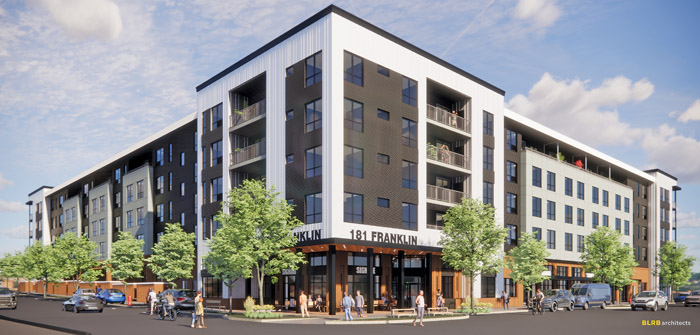(Rendering of prospective mixed-used multi-story building slated for 181 Franklin close to downtown Bend, designed by BLRB Architects, with commercial on the ground floor and residential units above, illustrating the City’s increasing urbanization | Rendering courtesy of BLRB Architects)
Central Oregon Brokers Cautiously Optimistic but Economic Impacts Linger
Despite suffering setbacks during the pandemic in 2020 and 2021, local specialists largely view the commercial real estate industry in Central Oregon as having a positive outlook heading into 2022, with the industrial and multi-family sectors in particular forecast to continue to thrive.
But there are continuing economic headwinds to navigate, in part due to COVID’s lingering impacts, with rising inflation, interest rate hikes, labor shortages and increased costs for construction materials part of the new reality.
Over the past year, a combination of labor shortages, supply chain disruption and economic growth pushed inflation to its highest rate in decades. In commercial real estate, in Central Oregon and the nation as a whole, the impact was largely felt in new construction, where materials drove project costs up significantly.
This inflationary pressure looks set to continue to impact construction costs. As a result, replacement costs should continue to rise and existing assets will likely benefit from demand shifting in their favor and drive more investment to the market as, historically, commercial real estate has provided a hedge against inflation.
A trend toward remote working will also continue to affect vacancy rates in the traditional office market.
Ron Ross, CCIM, who is a principal broker with Bend-based Compass Commercial and co-author of the company’s Points newsletter, observed, “Four major themes from 2021 will continue to drive Commercial Real Estate in Central Oregon in 2022: COVID, inflation, shortages and slowing growth.
“The pandemic is evolving, unpredictable and is not going away. It has produced both winners and losers in the business and real estate worlds as residential real estate markets in many locales, including Central Oregon, have exploded with in-migration.
“Increased working from home, the desire to escape high density, high traffic and high crime urban areas, and the increasing importance of home as a place of refuge drive this trend.
“As growth and demand for Central Oregon real estate signals a robust economy and builds wealth for homeowners and investors, the flip side is that it produces serious shortages and affordability problems.
“The multifamily and industrial sectors have seen the same trends as residential housing. Low vacancies, rapidly rising rents and a corresponding increase in market values reflect not only the residential in-migration but a growing trend of businesses moving in and starting up in Central Oregon.”
As part of that trend, Ross said industrial buildings locally are fully occupied and in huge demand, with the increasing popularity of online commerce amplifying the clamor for storage and distribution space.
Multifamily and industrial have been clear winners in the COVID era and indications are that there will continue to be new supply of both product types built and brought to market, though with higher rental rates potentially reflecting the increased costs of construction.
Latest figures show negligible vacancy rates of less than two percent in the industrial submarket in both Bend and Redmond, with the number of lease transactions limited only by a lack of available space, and rents on the rise in the face of tightened supply and rising costs in Bend.
Retail has been surprisingly resilient in the face of the pandemic. While some retailers suffered catastrophic blows, many have persevered with creative solutions, and even thrived — as a “testament to the spirit of enterprise and optimism.”
Consumer demand is robust and retail occupancy and lease rates remain strong, while some new retail construction in Central Oregon is either underway or in the pipeline.
The office sector is somewhat of a different story. While the trend toward remote working has been a factor for landlords, Bend office vacancies remain relatively stable at under ten percent, but with lease rates remaining flat.
Offices will change, but they won’t shutter, and are likely to look to upgrade to adjust with the times as the evolution of hybrid work and employee preferences has seen a continuing flight to quality, as employers follow the demand for spaces with attractive amenities and flexibility.
In the face of the relative uncertainty, there is no new office construction in Central Oregon.
Inflation is patently the most dominant economic theme through 2022, with multiple factors precipitating its highest levels in 35 years.
Ross added, “Real estate has long been known as a good inflation hedge. That is only partially true. The theory is that as inflation rises, rents will also rise.
“That does not hold true for properties that are locked into long term leases with low lease rate escalators. Like bonds, when inflation rises, the values for these properties can take a hit. It will be important for owners to ensure their income grows with the inflation rate.”
Shortages are another strain on the overall picture — in everything from housing to workers and products and services, further fueling inflationary pressure, though tempering an otherwise booming economy and real estate market.
Central Oregon will feel these shortages as acutely as any region in the country and affordability will continue to be problematic, though the Oregon legislature and jurisdictions such as Bend are trying to incentivize more attainable housing through increased flexibility and code changes to encourage development of more living options.
Ross does not see a recession looming but rather a slowing in growth. He said, “The hyper growth of 2021 is not sustainable, so a slowdown is inevitable. The Fed is changing course on monetary policy announcing the end to quantitative easing and probable interest rate hikes. For the most part that is good news, as it will help with inflation and supply chain disruptions.
“Early 2022 indications are that the hot real estate market trends are still in full force and Central Oregon continues to be an attractive destination for in-migration and investment dollars.”
From a macro perspective, many experts see so-called “secondary” markets such as the Bend-Redmond metro area continuing to outgrow the country’s major cities as, generally, prices tend to appreciate where jobs are available, and people are drawn.
In recent years, we have seen a migration from gateway cities to smaller markets, spurring opportunities in the latter and Central Oregon should continue to see relative growth as jobs, population migration and attractive market dynamics contribute to appreciating prices across the board.
Brian Fratzke, CCIM, principal broker and founder of Fratzke Commercial Real Estate Advisors, Inc. took more of a historical perspective regarding the regional market environment.
He said, “I began selling and leasing commercial real estate in Central Oregon on April 1, 2004. At that time, anyone and everyone made money in real estate in Central Oregon. As the saying went, ‘It was so easy, everyone was doing it’… And no one said that the market would ever go down.
“In 2008-2010, there were more than 1,000 fully finished vacant homes in Bend that no one wanted to purchase. We called them ‘See Through Homes’ because you could actually see through the windows because there was no one living in these houses. In the commercial real estate sector, two million square feet of move-in-ready industrial buildings sat vacant in Bend.
“Now, we are already into the second quarter of 2022, 12-14 years later. We have massive demand for both commercial and residential real estate. We have almost no industrial buildings for lease or for sale in all of Central Oregon.
“We have less than a two-week supply of homes in Bend and the median home price is quickly reaching $800,000. This demand is occurring while inflation in the United States between March 2021 and March 2022 increased from a traditional three percent year-over-year average to 10.8 percent. The interest rate on a 30-year traditional home loan has increased from 3.25 percent to five percent.
“Construction costs and taxes have never been higher since our country was established more than 245 years ago.
“We humans do not control the market any more than we control receiving over fifty inches of snow in April. Wise investors of real estate understand that they do not control much other than their financial position, and how they manage their debt, cash flow and spending habits.
“The costs associated with new construction will not decrease. There may be a buying opportunity at the national level but with so much cash chasing so few opportunities in Central Oregon, I do not see an implosion in commercial real estate values in our community happening any time soon.
“Compound this demand with the State of Oregon Urban Growth Boundary land use planning process that does not move quickly enough to accommodate market fluctuations, and we will continue to experience high demand with limited inventory.
“The demand by those wishing to locate to Central Oregon may be impacted over the short-term but overall, I expect Bend to become the second-largest city in Oregon behind the Portland Metro Area over the next 50 years.”



